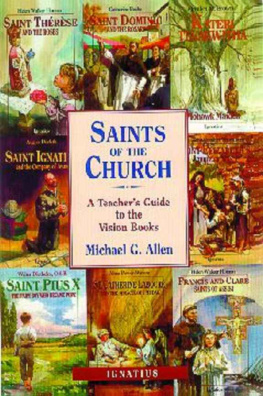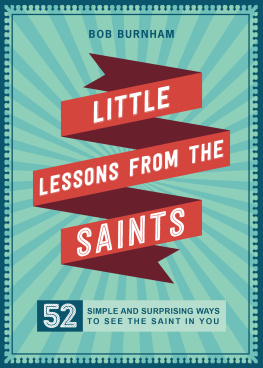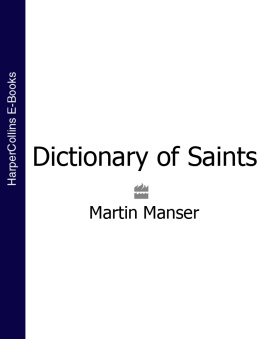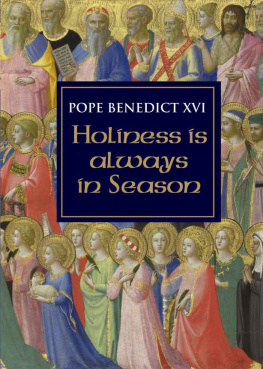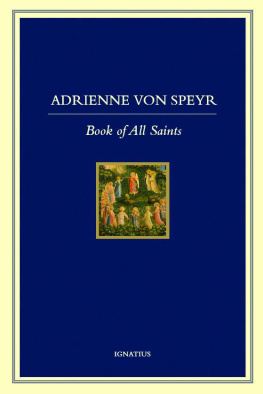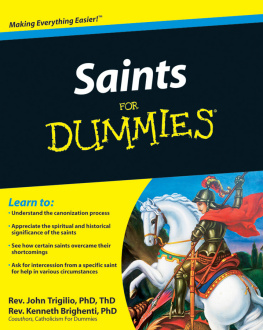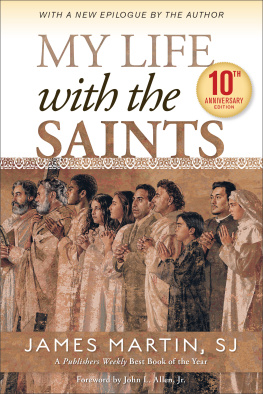Saints of the Church
MICHAEL G. ALLEN, Ed.D.
Saints of the Church
A Teachers Guide to the Vision Books
IGNATIUS PRESS SAN FRANCISCO
Vision Book cover art by Christopher J. Pelicano
Cover design by Riz Boncan Marsella
2000 Ignatius Press, San Francisco
All rights reserved
ISBN 978-0-89870-783-0 (PB)
ISBN 978-1-68149-420-3 (E)
Library of Congress control number 00-100240
Printed in the United States of America
Prayerfully dedicated to the
Blessed Virgin Mary ,
THEOTOKOS,
the Mother of God,
the Mother of All Mankind
CONTENTS
ACKNOWLEDGMENTS
Special thanks are joyfully extended to Father Brett Brannen, of the Diocese of Savannah, Georgia, for issuing the gentle but persistent challenge to turn my pen to the Lords work. Pax Domini sit semper vobiscum , Father Brett. To Brother Robert Sokolowski, S.M., who has allowed me to continue to serve at the altar, many thanks for your gentleness, patience, and guidance. Pax Domini sit semper vobiscum , Brother Robert. To Abbot George Hilgartner for simply being a friend. An appreciative Thanks to colleague Dr. James Stephens for his patience and skill in turning some twenty separate computer files into a single document through his special brand of computer expertise. Finally, a loving Thank You to Carole, my wife, for her inexhaustible patience this past year, as I struggled to turn an idea into a usable guide for parents and teachers in sharing the lives of saints with their children and students.
INTRODUCTION
The underlying purpose of this guide is both simple and practical. It aims to stimulate both the spiritual growth and intellectual development of students nine to fifteen years of age through an organized and systematic study of seventeen biographies of holy men and women. By interacting with their livesthe heroic sacrifices they offered to God, the conflicts they faced, the decisions they madestudents can better understand and overcome the challenges in their own lives.
Overview
The guide corresponds to seventeen of the Vision Books reprinted by Ignatius Press. The guide facilitates student interaction with the spiritual insights, moral lessons, and sound academic content found in each book. As such, it is interactive in nature.
The guide is divided into sections, each of which contains an overview of the subjects life and activities that illustrate this persons impact on the Church and his time. These activities are designed to challenge student thinking, to promote the application of spiritual insights to the readers personal life, and to expand the readers understanding of and appreciation for these examples of holiness, of the saints, and the Roman Catholic Church. (Most, but not all, of the Vision Book subjects are canonized saints. However, in the material that follows the word saint is used for the sake of simplicity.)
How to Use the Activities
The following explains the activity format of the guide. Directions for activities that are repeated with each Vision Book are provided here. Teachers can select any combination of activities for individual students, for those working in small groups, or for a class-wide, teacher-led discussion. The activities serve as a catalyst, or beginning point, for teachers to direct student learning. There are myriad other activities and questions that can be posed for students and by students beyond those provided in the guide.
1. CHAPTER VOCABULARY. A list of vocabulary words selected from each book is provided for each saint. The teacher can choose those appropriate for a vocabulary activity. Students should first locate the selected words in the story, then define the words by referring to a dictionary. Finally, students can use the words in complete sentences that describe important aspects of the saints life. Be sure students select the definitions that match the authors meaning. Students can compile individual vocabulary notebooks or develop a glossary of terms class project . Teachers can place the words on flash cards with corresponding definitions on the backs. The words can also be used as the basis for periodic spelling bees or tests and vocabulary quizzes. Expanding students working vocabulary is essential to improving both their oral and written communication skills.
2. LANGUAGE IN CONTEXT. Developing ones comprehension skills requires understanding the use of literary devices in particular contexts as well as comprehending the deeper meaning not readily apparent on first reading. Understanding an authors use of metaphors, similes, allusions, and symbols helps students better comprehend the story being told. Sentences selected for this segment have a deeper meaning that is important for students to probe for a better understanding of the text. Many sentences have double meanings, as it were, and point the reader to spiritual realities in the lives of the saints.
The location of each sentence in the story is indicated by the page number in parentheses. Students should first locate the sentence in the story, then carefully reread that segment of the story to determine its meaning. Students can develop a paragraph of three to four complete sentences that explains the meaning of each selection. Teachers can also use the sentences and students paragraphs as a springboard for a class discussion of a particular issue or as the basis for further reading, study, or research on a particular topic. This activity can also help students generate written reports or oral presentations.
3. TIME LINE. A time line can be constructed as a class project and hung in an appropriate place in the classroom. The students or teacher can print the dates provided on a continuous strip of paper. As the dates are encountered in the text, the events can be written onto the time line. The time line can be generated on a computer or printed by hand. Students can also illustrate the time line with drawings and symbols pertinent to the person, place, or event.
Students can also create a web that illustrates connections and important relationships between and among the saints studied. For example, students can visually show the obvious New World connections in the work of Isaac Jogues, Jacques Marquette, and Kateri Tekakwitha.
The significance of each date in this guide is identified. Teachers can add other appropriate dates of events and people from other parts of the world not directly associated with the particular saint to help place the saint in a larger historical framework. For example, during the life of the Cure of Ars, Saint John Baptist Vianney, major political and social events occurred in the United States of America as well as in France.
4. OUTLINE MAPS. Places pertinent to the saint can be located on appropriate outline maps. These are cumulative in nature and can be completed as an individual student activity or as a class project on a larger outline map. Displaying a large outline map somewhere in the classroom helps students visualize the geographical locations pertinent to a saints journey through life. Maps can be purchased or developed by the teacher with the aid of an overhead projector. Maps can be colored and illustrated by students. Students can also develop a map legend that explains various aspects of the map. This activity will build map making, reading, and interpreting skills. Students can also develop their own map portfolio, a sequential collection of maps from each saints life, which, among other things, show the slow development of nation-states in Europe and the changing political boundaries of the New World.
5. TOPICS FOR WRITTEN REPORTS. An extensive number of topics are provided to prompt independent research, library work, and further reading. These are opportunities to practice important language arts skills, especially in organizing information, outlining a topic, and conveying ideas in written form. This activity can also be organized for a class-wide, teacher-led discussion. While the structure of such reports is up to the teacher, questions are provided for each topic and can serve as a basic outline to direct the students research. The teacher can and should add other questions as appropriate to stress additional aspects of the topic under consideration. Each topic is followed by a page number indicating its location in the book being read.

